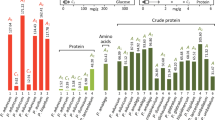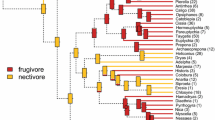Abstract
The efficiency of food exploitation correlates positively with the extent of dietary specialization. Neotropical nectar-feeding bats (Glossophaginae) have one of the most specialized diets among mammals, as floral nectar constitutes a sugar-rich and highly digestible but protein and fiber depleted food source. However, dietary constraints, such as a temporary scarcity of nectar, or protein demands may sometimes require the uptake of alternative food items. We investigated the influence of a diet switch from nectar to fruit on intestinal morphology, body mass, and energy budget in the nectar-feeding bat Glossophaga commissarisi and quantified feeding efficiency. We hypothesized that these nectar specialists depend on a constant supply of nectar, if they were lacking the ability for morphological and physiological plasticity in response to a fiber-rich diet. Although capable of harvesting infructescences of Piper hispidum, G. commissarisi was less efficient in extracting energy from fruits (48% digestive efficiency of total fruit energy content) than from nectar (c. 99% digestive efficiency). The intestinal morphology and organ masses did not change after bats were switched from nectar to fruits. Captive bats exhibited lower daily energy expenditures and flight activity when feeding on fruits than during nectarivory. Possibly, this may have been a deliberate regulation to balance reduced feeding efficiency, or simply the consequence of extended digestive pauses. The low digestibility of Piper, in combination with slow digestion and the bats’ inability for morphological and physiological plasticity may cause nectar-feeders to reduce their maximum energy expenditure when feeding on fruits. We argue that although fruits may substitute for nectar, they may cause restricted maximum energy assimilation compared with nectar.


Similar content being viewed by others
Abbreviations
- DM:
-
Dry mass
- bm:
-
Body mass
- DEE:
-
Daily energy expenditure
- DLW:
-
Doubly-labelled water
- SD:
-
Standard deviation
References
Aguirre LF, Herrel A, Van Damme R, Matthysen E (2003) The implications of food hardness for diet in bats. Funct Ecol 17:201–212
BfEL (Federal Research Centre for Nutrition and Food) (2007) Bundeslebensmittelschlüssel (BLS). Federal Ministry of Food, Agriculture and Consumer Protection, Bonn
Bonaccorso FJ, Gush TJ (1987) Feeding behavior and foraging strategies of captive phyllostomid fruit bats: an experimental study. J Anim Ecol 56:907–920
Boyles JG, Storm JJ (2007) The perils of picky eating: dietary breadth is related to extinction risk in insectivorous bats. PLoS ONE 2:e672
Bozinovic F, Muñoz JLP, Naya DE, Cruz-Neto AP (2007) Adjusting energy expenditures to energy supply: food availability regulates torpor use and organ size in the Chilean mouse-opossum Thylamys elegans. J Comp Physiol B 177:393–400
Delorme M, Thomas DW (1996) Nitrogen and energy requirements of the short-tailed fruit bat (Carollia perspicillata) fruit bats are not nitrogen constrained. J Comp Physiol B 166:427–434
Delorme M, Thomas DW (1999) Comparative analysis of the digestive efficiency and nitrogen and energy requirements of the phyllostomid fruit-bat (Artibeus jamaicensis) and the pteropodid fruit bat (Rousettus aegyptiacus). J Comp Physiol B 169:123–132
Dumont ER (1999) The effect of food hardness on feeding behaviour in frugivorous bats (Phyllostomidae): an experimental study. J Zool Lond 248:219–229
Dyer LA, Palmer ADN (2004) Piper. A model genus for studies of evolution, chemical ecology, and trophic interactions. Kluwer, Boston
Fleming TH (1988) The short-tailed fruit bat—a study of plant-animal interactions. The University of Chicago Press, Chicago
Forman GL, Phillips CJ, Rouck CS (1979) Alimentary tract. In: Baker RJ, Knox Jones J Jr, Carter DC (eds) Biology of bats of the New World family Phyllostomidae. Spec Publ Mus Texas Tech Univers 16, Part III, pp 205–227
Freeman PW (1995) Nectarivorous feeding mechanisms in bats. Biol J Linn Soc 56:439–463
Gardner AL (1977) Feeding habits. In: Baker RJ, Knox Jones J Jr, Carter DC (eds). Biology of bats of the New World family Phyllostomidae. Spec Publ Mus Texas Tech Univers 16, Part II, pp 293–350
Howell DJ (1974) Bats and pollen: physiological aspects of the syndrome of chiropterophily. Comp Biochem Physiol A 48:63–276
Jung HJG, Batzli GO (1981) Nutritional ecology of microtine rodents: effects of plant extracts on the growth of Arctic microtines. J Mammal 62:286–292
Karasov WH, Hume ID (1997) Vertebrate gastrointestinal system. In: Dantzler W (ed) Handbook of comparative physiology. American Physiological Society, Bethesda, MD
Kelm DH, von Helversen O (2007) How to budget metabolic energy—torpor in a small Neotropical mammal. J Comp Physiol B 177:667–677
Korine C, Arad Z, Arieli A (1996) Nitrogen and energy balance of the fruit-bat Rousettus aegyptiacus, on natural fruit diets. Physiol Zool 69:618–634
Król E, Redman P, Thomson PJ, Williams R, Mayer C, Mercer JG, Speakman JR (2005) Effect of photoperiod on body mass, food intake and body composition in the field vole, Microtus agrestis. J Exp Biol 208:571–584
Law BS (1992) The maintenance nitrogen requirements of the Queensland blossom bat Syconycteris australis on a sugar-pollen diet—is nitrogen a limiting resource? Physiol Zool 65:634–648
Lee WB, Houston DC (1993) The effect of diet quality on gut anatomy in British voles (Microtinae). J Comp Physiol B 163:337–339
Lifson N, McClintock R (1966) Theory of use of the turnover rates of body water for measuring energy and material balance. J Theor Biol 12:46–74
Loeb SC, Schwab RG, Demment MW (1991) Responses of pocket gophers (Thomomys bottae) to changes in diet quality. Oecologia 86:542–551
Lopez J, Vaughan C (2007) Food niche overlap among Neotropical frugivorous bats in Costa Rica. Rev Biol Trop 55:301–313
Lusk G (1976) The elements of the science of nutrition. Johnson, New York
Makanya AN, Mayhew TM, Maina JN (1995) Stereological methods for estimating the functional surfaces of the chiropteran small intestine. J Anat 187:361–368
McWilliams SR, Karasov WH (2001) Phenotypic flexibility in digestive system structure and function in migratory birds and its ecological significance. Comp Biochem Physiol A 128:579–593
Morrison DW (1980) Efficiency of food utilization by fruit bats. Oecologia 45:270–273
Nagy KA (1983) The Doubly Labeled Water (3HH18O) Method: a guide to its use. UCLA Publication 12–1417. UCLA, Los Angeles, CA
Naya DE, Bacigalupe LD, Bustamante DM, Bozinovic F (2005) Dynamic digestive responses to increased energy demands in the leaf-eared mouse (Phyllotis darwini). J Comp Physiol B 175:31–36
OTS (Organization for Tropical Studies) (2006) La Selva biological station meteorological data. Available at: http://www.ots.ac.cr
Piersma T, Gill RE Jr (1998) Guts don’t fly: small intestinal organs in obese bar-tailed Godwits. Auk 115:196–203
Pyke GH (1984) Optimal foraging theory: a critical review. Ann Rev Ecol Syst 15:523–575
Richardson KC, Jarett L, Finke EH (1960) Embedding in epoxy resins for ultrathin sectioning in electron microscopy. Stain Technol 35:313–323
Schoener TW (1971) Theory of foraging strategies. Ann Rev Ecol Syst 2:369–404
Speakman JR (1993) How should we calculate CO2 production in doubly labeled water studies of animals? Funct Ecol 7:746–750
Speakman JR (1997) Doubly labelled water—theory and practice. Chapman & Hall, London
Speakman JR (1998) The history and theory of the doubly labeled water technique. Am J Clin Nutr 68:932S–938S
Speakman JR, Król E (2005) Validation of the doubly-labelled water method in a small mammal. Physiol Biochem Zool 78:650–667
Speakman JR, Racey PA (1987) The equilibrium concentration of O-18 in body-water—implications for the accuracy of the doubly-labeled water technique and a potential new method of measuring RQ in free-living animals. J Theor Biol 127:79–95
Speakman JR, Racey PA (1988a) Validation of the doubly labeled water technique in small insectivorous bats by comparison with indirect calorimetry. Phys Zool 61:514–526
Speakman JR, Racey PA (1988b) Consequences of non steady-state CO2 production for accuracy of the doubly labeled water technique—the importance of recapture interval. Comp Biochem Physiol A 90:337–340
Speakman JR, Racey PA, Haim A, Webb PI, Ellison GTH, Skinner JD (1994) Interindividual and intraindividual variation in daily energy-expenditure of the pouched mouse (Saccostomus-campestris). Funct Ecol 8:336–342
Speakman JR, Nagy K, Masman D, Mook WG, Poppitt SD, Strathern GE, Racey PA (1990) Interlaboratory comparison of different analytical techniques for the determination of Oxygen-18 abundance. Anal Chem 62:703–708
Starck JM (1999) Phenotypic flexibility of the avian gizzard: rapid, reversible and repeated changes of organ size in response to changes in dietary fiber content. J Exp Biol 202:3171–3179
Telez G, Ortega J (1999) Musonycteris harrisoni. Mammal Species 622:1–3
Tschapka M (2004) Energy density patterns of nectar resources permit coexistence within a guild of Neotropical flower-visiting bats. J Zool Lond 263:7–21
von Helversen O, Reyer H-U (1984) Nectar intake and energy expenditure in a flower visiting bat. Oecologia 63:178–184
von Helversen O, Winter Y (2003) Bats and flowers. In: Kunz TH, Fenton MB (eds) Bat ecology. University of Chicago Press, Chicago, IL
Van Soest PJ (1994) Nutritional ecology of the ruminant. Cornell University Press, Ithaka, NY
Van Trigt R, Kerstel ERT, Neubert REM, Meijer HAJ, McLean M, Visser GH (2002) Validation of the DLW method in Japanese quail at different water fluxes using laser and IRMS. J Appl Physiol 93:2147–2154
Visser GH, Schekkerman H (1999) Validation of the doubly labeled water method in growing precocial birds: the importance of assumptions concerning evaporative water loss. Physiol Biochem Zool 72:740–749
Veloso C, Bozinovic F (1993) Dietary and digestive constraints on basal energy metabolism in a small herbivorous rodent. Ecology 74:2003–2010
Voigt CC (2000) Intraspecific scaling of flight power in the bat Glossophaga soricina (Phyllostomidae). J Comp Physiol B 170:403–410
Voigt CC (2003) Reproductive energetics of the nectar-feeding bat Glossophaga soricina (Phyllostomidae). J Comp Physiol B 173:79–85
Voigt CC, Winter Y (1999) Energetic cost of hovering flight in nectar-feeding bats (Phyllostomidae: Glossophaginae) and its scaling in moths, birds and bats. J Comp Physiol B 169:38–48
Voigt CC, Speakman JR (2007) Nectar-feeding bats fuel their high metabolism directly with exogenous carbohydrates. Funct Ecol 21:913–921
Voigt CC, Kelm DH, Visser GH (2006) Field metabolic rates of phytophagous bats: do pollination strategies of plants make life of nectar-feeders spin faster? J Comp Physiol B 176:213–222
Webster WD, Knox-Jones J (1993) Glossophaga commissarisi. Mammal Species 446:1–4
Wilkinson GS, Fleming TH (1996) Migration and evolution of lesser long-nosed bats Leptonycteris curasoae, inferred from mitochondrial DNA. Mol Ecol 5:329–339
Winter Y (1998) In vivo measurement of near maximal rates of nutrient absorption in a mammal. Comp Biochem Physiol 119 A:853–859
Winter Y, von Helversen O (2003) The operational tongue length in phyllostomid nectar-feeding bats. J Mammal 84:886–896
Acknowledgments
We would like to thank the Organization for Tropical Studies and the Costa Rican authorities, namely Javier Guevara (SINAC) for research permissions. We thank Dagmar Viertel, Doris Krumnow and Doris Fichte for histological preparation and evaluation, Heidrun Barleben and Doreen Pick for nutritional analysis, Paula Redman for DLW analysis, Mirkka Jones for proofreading, all helpers in the field and two anonymous reviewers for improving the manuscript. The experiments complied with the Costa Rican law and were approved by the Costa Rican Ministry for Environment and Energy (MINAE). This study was financed by the DFG grant Vo 890-10.
Author information
Authors and Affiliations
Corresponding author
Additional information
Communicated by G. Heldmaier.
Rights and permissions
About this article
Cite this article
Kelm, D.H., Schaer, J., Ortmann, S. et al. Efficiency of facultative frugivory in the nectar-feeding bat Glossophaga commissarisi: the quality of fruits as an alternative food source. J Comp Physiol B 178, 985–996 (2008). https://doi.org/10.1007/s00360-008-0287-3
Received:
Revised:
Accepted:
Published:
Issue Date:
DOI: https://doi.org/10.1007/s00360-008-0287-3




